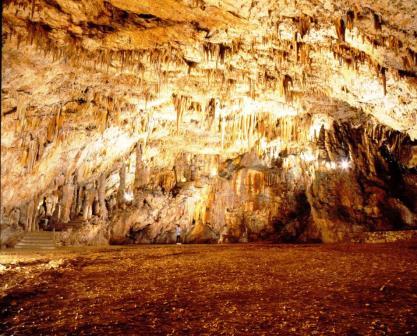The area of Sami takes up the Eastern side of Kefallonia and is the central port of the island. Every day ships connect Sami with Patras, Ithaca, Lefkada, and Astakos, while in summer you can take a ship to Corfu or Italy. Sami is very important not only from historical and archaeological aspect, but mainly from geological, because in the area there is a rare speleological park.
In the recent history of Sami, the Radical Elias Zervos Iakovatos, a famous personality who played an important role at the Liberation of Kefallonia during the English occupation, was born in the village of Zervata and the adjacent village of Mouzakata became a holocaust during the German Possession.
Recently many scenes of the film “Captain’s Corelli mandolin” ware shot in Sami.
SAMI: On the hill exactly behind Sami there exist many ruins of cyclopean walls (especially of Acropolis Cyatis) dating back to the ancient city-state. Ancient Sami was the only one of the four city-states of Tetrapolis that resisted alone against the Romans until the entire fall (188 b.C.). From the top of the hill you will be able to admire the view and walk among the ruins of the old monastery of Agii Fanentes established in the 2nd a.C. from the gnostic Epiphanis. It is worthwlile visiting the Roman Bath with the mosaic. Some finds from excavations are now exhibited in the Archaeological Museum in Argostoli. In the imposing church of Panagia Loutriotissa the holy icon of the throne was donated by the victorious united Christian fleet.
MONASTERY OF VIRGIN MARY IN AGRILIA: On the homonymous hill east of Same is lying the historical monastery that was founded in the 15th c. Try to ascend the hill and admire the picturesque gulf of Sami, as well as the iconostasis of the church and its semi-ruined belfry. On the road to Agrilia you will pass from Tseka, an excavation site plenty of Pre-Mycenaean funeral finds.
GRIZATA: The excavations of the summer of 1997 brought to light extensive remnants of ancient settlements and a lot of ostraca.
POULATA: Don’t forget to visit the marvellous –architectonally- church of Saint Spyridon with its iconostasis of excellent wood-curved techinique and its renaissance-type belfry.
PYRGI: In the semi-mountainous area of Pyrgi there are traces of ancient fortifications (Kastraki) and some villages abandoned after the seismic catastrophe of 1953 (like Staveri or Isaveri with the old church of Archangel). Towards Poros and leaving behind you Harakti, you will see on your left Akoli or Avythos lake – it is considered that it has no bottom- which is one of the most rich in flora and fauna hydrobiotop – hydrobiological place.
DROGKARATI: A cave of exceptional acoustics, located 4km. S.W. of Same, full with unique red stalagmites and stalactites. Take with you a pullover and get down with attention the steps leading to the central hall, or “Hall of Apotheosis” as it is known. In the 60’s the famous soprano Maria Kallas sang in this hall and nowadays, during the summer take place some musical events.
ΜELISSANI: Two kilometers away from Sami, near the picturesque Karavomilos, is located the deep lacustrine cave of Melissani, one of the dream of the underground world. It is shaped in B form, its total length is more than 150 m., its width is approximately 25 m. and its depth is little more than 36 m. The roof on the southern side has collapsed leaving an opening 50 m. long and 30 m. wide as a result of which, the rays of the midday sun penetrating the aperture and playing with the transparent crystal blue waters create an excellent combination of colours. This phenomenon is visible by those inside the cave as well as by those from the gallery in the wild-vegetation-covered aperture. Formation of 20.000 years old stalactites, in many sizes and abnormal shapes, decorate the precipitous walls of this cauldron. Towards the middle of the lake, where the roof has not collapsed, there is a small island measuring 30 m. in length. It has been created by the fall of the rocks of the stalactites. From its surface rise two tiny hills. From the excavations made in 1951, some finds came into light which are exhibited in the Archaeological Museum in Argostoli. They are made of clay and had been offered to Pan and the Nymphs of the Cave. It is worthwhile getting in a boat and making the round of this fantastic and unique cave.
AGGALAKI: Among the 17 known caverns of the area is Aggalaki, located between Poulata and Karavomylos. It has two rooms –one small and one double in size from the first- which are placed verticaly. Marvellous stalactites of various sizes and forms are mirrored in the crystal waters of the lake.
ANTISAMOS: In an evergreen bay N.E. and 4 km away from Sami is hidden a magnificent beach with a Blue Flag award. You have to be careful because the waters of sea deepen somehow abruptly. Before the big turn towards Antisamos, you must stop for a while a little above the cape Mytikas and wander in the old and abandoned village of Dihalia. In addition, a walking trail that begins from the old church of Sami leads to Antisamos (Information at the Municipality).
KARAVOMYLOS: The beach has pebbles and the waters is somehow cold. This is owed to the geological phenomenon that in this territory the sea water from Argostoli –i.e. from Katavothres- comes out after been mixed with the underground waters. Don’t hesitate to walk around the picturesque little pond, feed the ducks, take photos near the iron mill that makes visible the phenomenon of Katavothres. Please watch the direction of the mill: the water from the pond directs to the sea.
BEACHES ALONGSIDE THE ROAD TO AGIA EUFIMIA– AGIA PARASKEVI: Driving towards Agia Eufimia you will meet fantastic small beaches with clear blue waters, sometimes with pebbles, sometimes with white sand. The largest of all is Agia Paraskevi.
Evridiki Livada

